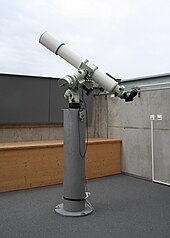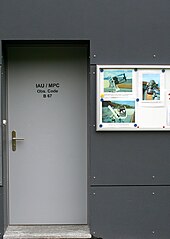Mirasteilas observatory
The Mirasteilas observatory ( Rhaeto-Romanic «stargazer») is an observatory in Falera in the Surselva in the Swiss canton of Graubünden . It is equipped with a 90-centimeter reflector telescope , making it the largest publicly accessible observatory in Switzerland.
history
In 2001, the local José De Queiroz , born in Portugal, innkeeper in Falera and member of the Astronomical Society of Graubünden, organized an astronomy meeting in Falera for the first time. Thanks to its good accessibility, its elevated position on a terrace with a wide sky to the west, south and east and low light pollution, the place offered and still offers ideal conditions for observing the stars.
In 2002, at another telescope meeting in Falera, the question arose whether an observatory could not be built here. The local council recognized that the construction of an observatory would be a big gain for the village, as there was no such facility in Graubünden at the time. Members of the local council and the Graubünden Astronomical Society then visited various observatories in eastern Switzerland to find out about observatories . A suitable location was a few minutes outside the village by the meadow with the children's ski lift.
On September 11th, 2002 a working group was formed and the architects Schneider & Cathomas from Falera took over the planning of the observatory. On December 5, 2005, the community assembly approved a construction loan of 690,000 francs for the construction of the facility. In addition to the observatory, there should also be a small restaurant for visitors to the ski meadow. A foundation was set up as sponsor , in which the political community Falera, the AGG and Flims-Laax-Falera-Tourismus were part. The groundbreaking ceremony took place on May 9, 2006 and the restaurant was opened in winter 2006/2007. Since the delivery of the large telescope was somewhat delayed, the observatory could not be put into operation until June 22, 2007.
building
The core of the public observatory is the observation platform on the first floor with the observation instruments. The roof can be retracted on two rails so that the instruments and audience have a clear view of the sky. A separate foundation was created to prevent vibrations being transmitted to the telescope. A technical room, a small restaurant and sanitary facilities are integrated in the wheelchair-accessible building, which can be used by visitors to the children's ski slope during the day and by observatory visitors in the evening. Introductory events or bad weather programs are also held in the restaurant room for visitors to the observatory.
Instruments
The main instrument, a Cassegrain telescope with a Nasmyth focus, a mirror diameter of 90 centimeters and a focal length of 9 meters , is one of the largest telescopes open to the public in Europe. It can be enlarged up to 1000 times. The instrument is fully computer controlled and can be automatically aimed at any object in the sky. The eyepiece opening is located on the side of the device in the declination axis at a viewing height of 145 cm. Data: free opening 900 mm, focal length 9000 mm, with reducer 5940 mm.
A Takahashi type FS-15 is available as a second instrument. It is a classic lens telescope . The instrument is particularly suitable for planetary observations. Data: clear aperture 152 millimeters, focal length 1216 millimeters.
To view nebulae , galaxies and star clusters in a large field of view, a binocular specially built for astronomical purposes is available. Data: 25 × 100 millimeters on fork mounting, optics: opening 100 millimeters. An astrograph is available on a separate mount for astrophotography .
business
The observatory is operated by the Graubünden Astronomical Society AGG. Around 30 trained demonstrators are available for visitors to take turns. Public tours take place on Friday and Saturday or by appointment.
Observations
Thanks to its high-quality instruments, Mirasteilas can also work scientifically. The Falera observatory, along with the Winterthur, Carona and Ependes observatories, is one of those stations that observe asteroids , comets and satellites and measure their orbit. The data will be sent to the Minor Planet Center of the International Astronomical Union. There they are available to science for further research. The individual measurements make it possible to record changes in the orbit of known asteroids or to calculate the orbits of newly discovered objects and thus discover possible dangers in good time.
Minor planet «Falera»
The asteroid " Falera " was discovered on November 21, 2009 by the founder of the observatory, José De Queiroz. The object has a diameter of around 3 kilometers. The asteroid orbits the sun at an average distance of around 471 million kilometers and needs 5 years and 6 months for a complete orbit. At the time of its discovery, the asteroid was around 315 million kilometers from Earth. Its brightness was more than 16,000 times weaker than the stars in the sky that can be seen with the naked eye.
On May 26, 2010, the International Astronomical Union and the Minor Planet Center at Cambridge University gave the asteroid with the serial number 233943 the name "Falera". The assignment of this name recognizes the work of the Mirasteilas observatory, which has been dealing with the discovery and orbit determination of unknown minor planets since 2008. The official text of the naming is archived in the “Minor Planet Center”.
Web links
- Website Mirateilas
- Mirasteilas
- Website of the Graubünden Astronomical Society
- NZZ
- Karin Huber: Magical star shine in the sky of Falera ; «Exclusiv» magazine 60 / Winter 2019/20, p. 11
Individual evidence
- ↑ Page no longer available , search in web archives: Astronomie Graubünden
- ↑ 'Graubünden Exclusiv', Winter 2009 edition
- ↑ NZZ report
- ^ Minor planet Falera
Coordinates: 46 ° 48 '15.4 " N , 9 ° 13' 26.2" E ; CH1903: 736,267 / 185230




